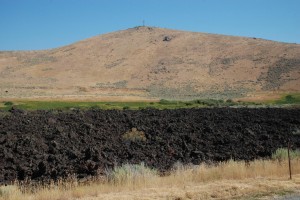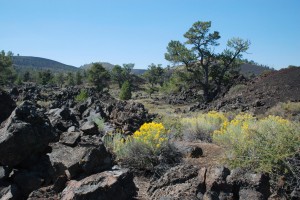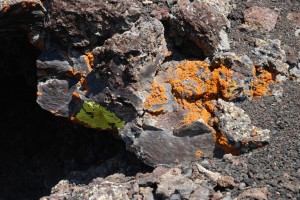Leaving Jerome, we continued to drive thru agricultural area areas where hay and Idaho potatoes (what else?) appeared to be the main crops. 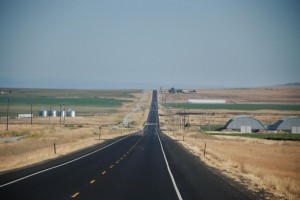
From time to time, we’d spot cattle grazing on both fenced and open range land. Surprisingly, however, given the lack of trees as far as the eye could see, we passed a couple of logging operations. 
Where the farms were absent, flat to gently rolling expanses of sagebrush ran to the horizon or to where the distant mountains rose from the valley floor. 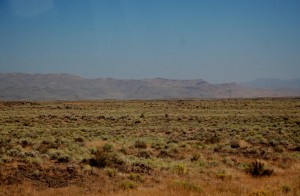
After a couple of hours on the road, we came over a rise and were amazed to see large but isolated mounds of “Aa” lava on both sides of the road 
A quick digression: There are four basic types of lava.
Aa flows are emitted from the vent at high rates ranging to 50km an hour, often as a fountain. It flows are animated with sporadic bursts of energy. Aa lava may push down houses, walls and forests. The hallmark of Aa lava flows is the very rough surface it produces when it cools.
Pahoehoe lavas are thin. They flow smoothly and are often formed by small volumes of hot, fluid basalt. Pahoehoe flows move forward in tongues or lobes and are characterized by a glassy, plastic skin. When the Pahoehoe lava flow cools, it often solidifies to a smooth surface.
Sheet lavas emerge from fissure systems forming flows commonly ranging between 10m and 30m in thickness. They flow out so fast that vast volumes of basalt are discharged over an enormous area and featureless lava plateaus are formed.
Block lavas often emerge in a fairly viscous state. Although they occasionally look similar, Black lavas tend to be both stronger and thicker than Aa lava flows and are much less rough and pitted. When solidified, they are characterized by often cubic masses with relatively smooth faces. .
In addition, cinder cones are another type of volcanic remains. They are made up of loose scoria which forms when blobs of gas-charged lava are thrown into the air during an eruption and cool in flight … falling as dark volcanic rock containing cavities created by the trapped gas bubbles.
Shortly after stumbling on the first lava fields, we reached the entrance to Craters of the Moon National Monument. This 750,000 acre monument incorporates lava fields, the oldest of which are 15,000 years old while the most recent erupted only 2,000 years ago. As the result of plate tectonics, the underlying hot spot which caused the eruptions presently lies under Yellowstone National Park. However, the volcanic fissures at Craters of the Moon are considered to be dormant, not extinct, and are expected to erupt in less than a thousand years.
We unhooked our Jeep for the drive through the accessible section of the monument, stopping for sort hikes at several trailheads.
Our drive and hikes took us through some fascinating lava formations. 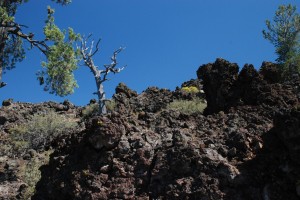
We also hiked up Inferno Cone, as cinder cone
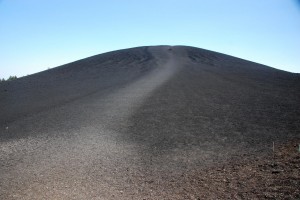
 where there were great views of the surrounding lava fields and spatter cones.
where there were great views of the surrounding lava fields and spatter cones. 
Big Cinder Butte on horizon, one of the world’s largest basaltic cinder cones
We were completely surprised at how light the very porous Aa rocks felt, as well as the small cinder particles on the cinder cones.
There were also many twisted tree trunks which had been killed during eruptions hundreds of years in the past … and which had not rotted away due to the hot and dry climate. 
We were also treated to the flitting of butterflies and grasshoppers. 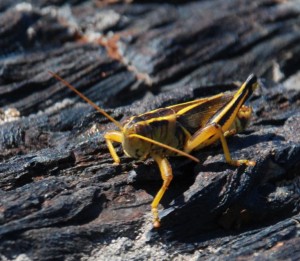
are typically the first life to emerge after an eruption and help breakdown the lava into soil which then helps support flowers, sagebrush, limber pines and other early emerging plants.
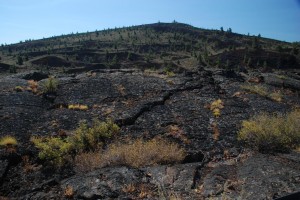 2,000 year old cone with Limber Pine and Antelope Bitterbush on its slopes
2,000 year old cone with Limber Pine and Antelope Bitterbush on its slopes
 7,500 year old cone with Douglas Fir and Sagebrush adorning its slopes
7,500 year old cone with Douglas Fir and Sagebrush adorning its slopes
While somewhat out-of-the-way, Craters of the Moon is definitely a worthwhile stop!

